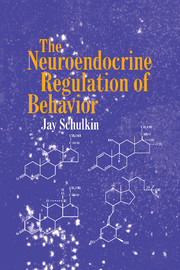Book contents
- Frontmatter
- Contents
- Acknowledgments
- Introduction
- 1 Hormones, Development, and Sexual Dimorphic Behaviors
- 2 Hormonal Regulation of Sodium and Water Ingestion
- 3 Hormonal Regulation of Food Selection
- 4 Hormones, Parental Care, and Attachment Behaviors
- 5 Hormonal Regulation of Fear and Stress
- 6 Hormones, Behavior, and Biological Clocks
- Conclusion
- References
- Name Index
- Subject Index
3 - Hormonal Regulation of Food Selection
Published online by Cambridge University Press: 25 January 2011
- Frontmatter
- Contents
- Acknowledgments
- Introduction
- 1 Hormones, Development, and Sexual Dimorphic Behaviors
- 2 Hormonal Regulation of Sodium and Water Ingestion
- 3 Hormonal Regulation of Food Selection
- 4 Hormones, Parental Care, and Attachment Behaviors
- 5 Hormonal Regulation of Fear and Stress
- 6 Hormones, Behavior, and Biological Clocks
- Conclusion
- References
- Name Index
- Subject Index
Summary
Introduction
Wild animals spend much of their time foraging for food. Underlying these behavioral events are hormonal changes. Together, behavioral and endocrine mechanisms serve the end point of nutrient homeostasis. What is homeostasis? Broadly conceived, it is defined as maintenance of the internal milieu – keeping adequate amounts of glucose, sodium, calcium, and other substances within the body through physiological as well as behavioral means. Homeostasis is key to maintaining the well-being of all living organisms (Oftedal, 1991).
The concentrations of a number of hormones are elevated or lowered when animals are hungry and are searching for food. For instance, corticosterone (secreted by the adrenal gland) and neuropeptide Y (synthesized by neurons in the brain) together generate the central motive state of searching for and ingesting food (e.g., Dallman et al., 1993; Leibowitz, 1995). Other hormones are increased when an ingested meal is utilized. For example, increases in insulin (fundamental in glucose utilization and energy and fat metabolism) (Woods et al., 1979) and two other satiating hormones (cholecystokinin and oxytocin) (Gibbs, Young, and Smith, 1973; Verbalis et al., 1993; Smith, 1997) and a protein (leptin) (Seeley et al., 1996) signal the termination of a meal. These hormones also influence food selection and food avoidance.
Food selection involves appetitive (search) and consummatory (ingestion) behaviors that reflect the central state of hunger (Stellar and Stellar, 1985). Consider, for example, the appetitive and consummatory phases of motivation in hungry rats.
- Type
- Chapter
- Information
- The Neuroendocrine Regulation of Behavior , pp. 85 - 115Publisher: Cambridge University PressPrint publication year: 1998



